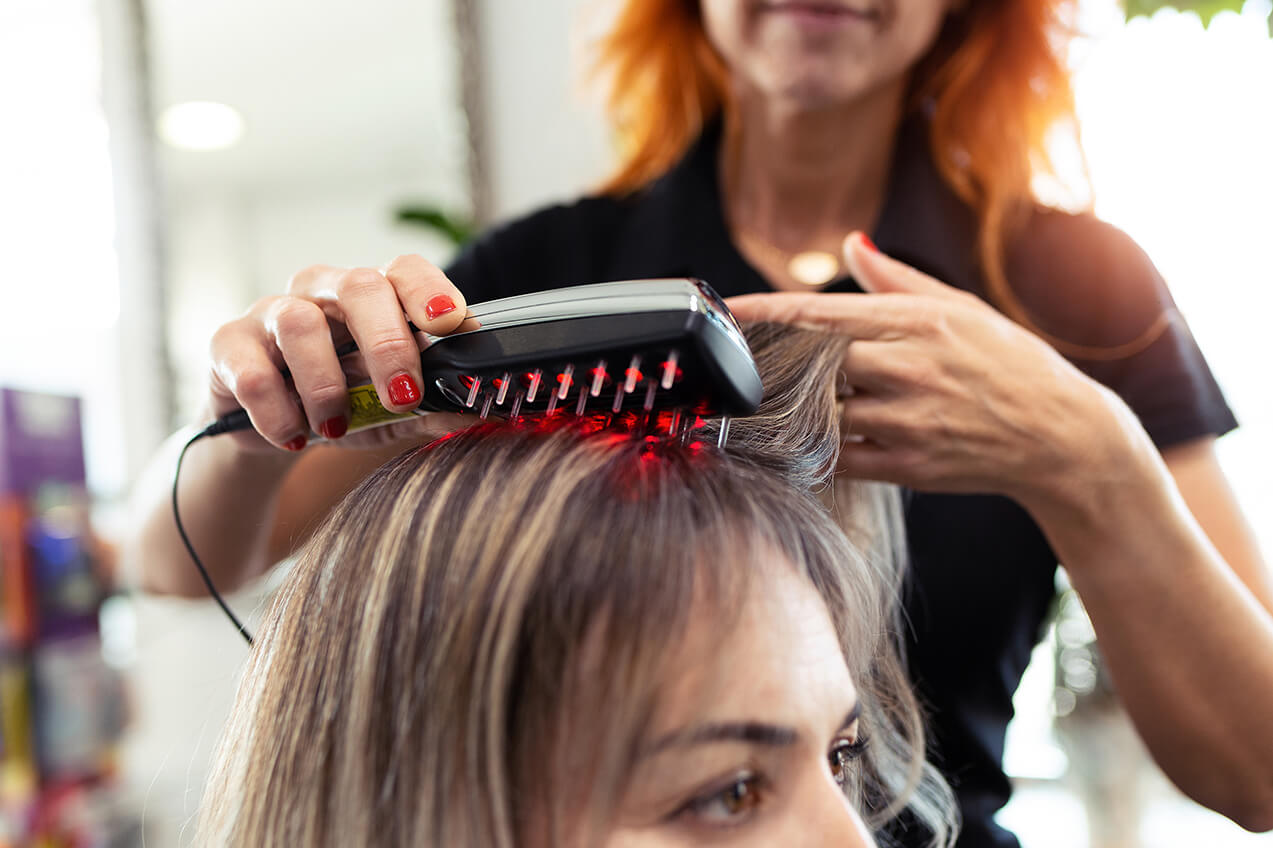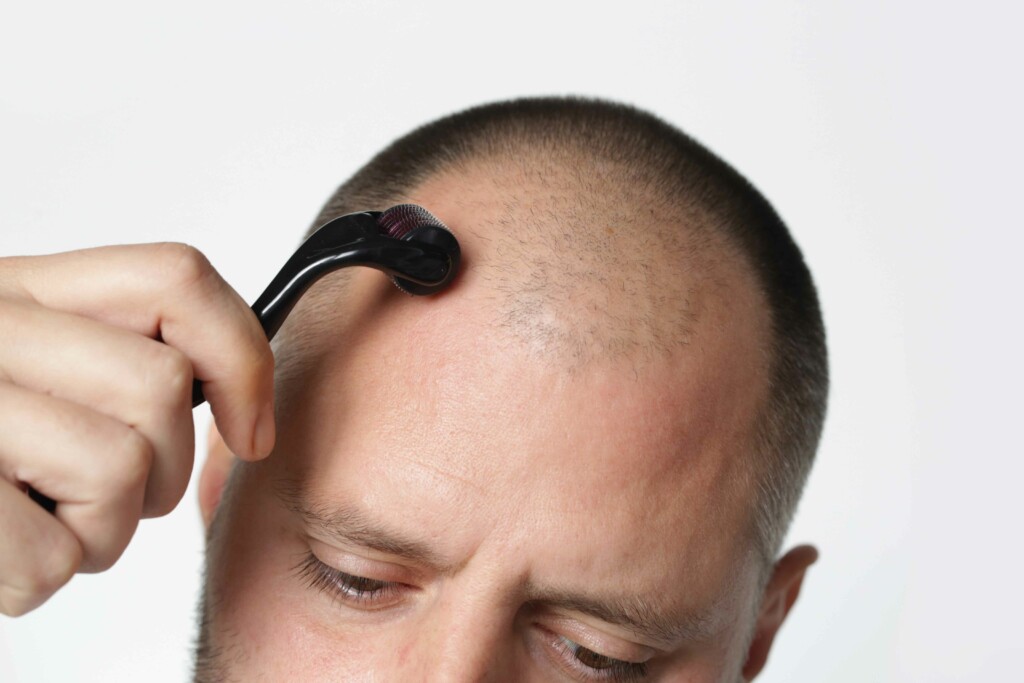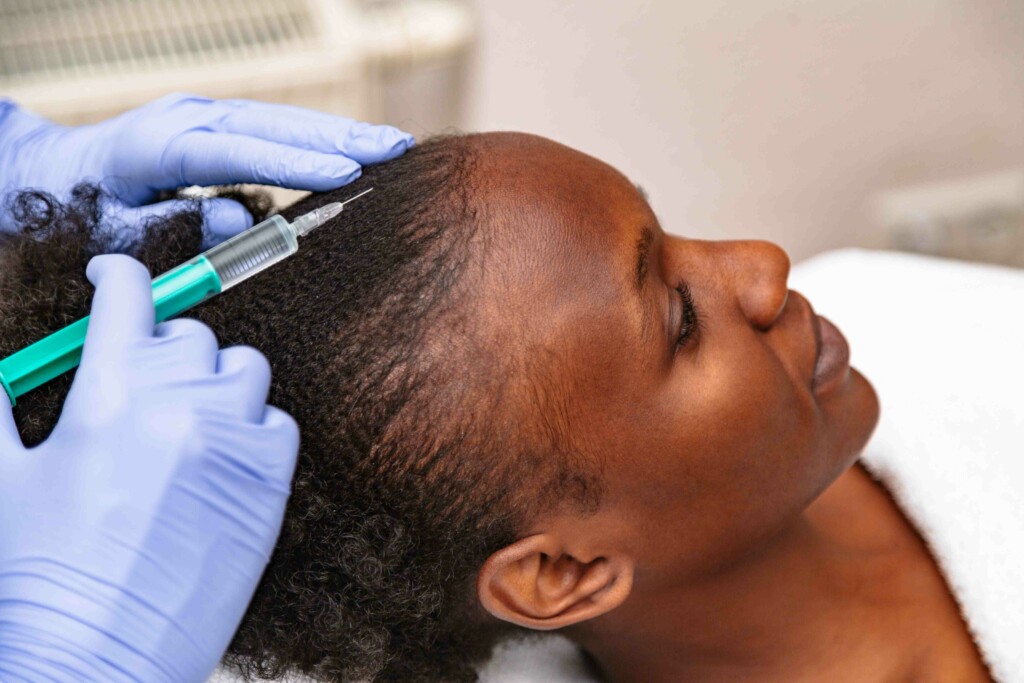Since 2007, numerous low-level laser therapy devices have been developed, including laser combs, brushes, baseball-style caps, helmets, and hairbands. Larger, more sophisticated LLLT equipment can often be found in dermatology clinics. Within a few months, consistent use of low-level lasers can stimulate hair regrowth in people trying to combat pattern baldness (also known as androgenetic alopecia). (2)
Determining the cost of LLLT for treating hair loss depends on a variety of factors. The type of device being purchased, the level of treatment you need, and whether you are treating hair loss at home or in a professional’s office are all important elements. On average, LLLT devices for home use can range from $200 to $3,000 USD. These devices are sold in multiple countries around the world, but for simplicity, all the prices listed in this article will be stated in United States Dollars ($).
Laser Hair Therapy Devices
There are a wide range of LLLT devices available for purchase, including laser combs, brushes, caps, helmets, and headbands. These are all typically used once per day and are simple to operate in the comfort of your own home. You simply need to wear the cap, helmet, or headband, or use the comb or brush for a certain length of time.
Laser hair therapy devices can contain LED lights, lasers, or a mix of the two, but the underlying concept stays the same. Emitting low-level laser light to the scalp can help promote hair growth over time!
Laser Combs and Brushes
Some of the most portable and easy to use LLLT devices include laser combs and brushes. Just like you would use a regular comb or brush, these devices are designed to be brushed through hair.
Inside the teeth of these brushes and combs are laser diodes or LEDs, providing low-level laser light directly to the scalp. Using these devices for 10 to 15 minutes, 3 days a week can help stimulate hair growth and improve hair thickness. (3)
Devices include the HairMax LaserComb®, NutraStim Laser Comb, LaserBrush from Sunetics, and the Yeamon Laser Comb. These devices typically hold between 5 and 12 lasers or LEDs that deliver low-level laser light to the scalp, which is thought to stimulate cellular growth and improve blood flow. (17)
Laser Headbands
Another type of device that can treat thinning and loss of hair is the laser headband. These U-shaped devices typically contain more LEDs or lasers than combs and brushes, but fewer than caps and helmets.
Like brushes, laser headband devices contain a couple rows of teeth to help separate hair during use, but the laser diodes or LEDs are housed behind a clear shield on the inside of the device. These devices are placed at the hairline, then moved backwards along the head over a certain length of time, depending on the manufacturer’s instructions.
For example, the Hairmax Laserband 82®, which is named for the 82 lasers it houses, starts at the hairline, and must be slid back to the middle and rear areas of the head after 30 seconds on each area. This results in a 90-second total treatment time. Like other devices, it’s meant to be used about three times a week. (4)
Laser Caps
One of the more popular LLLT devices are laser caps, which are designed to look like stylish baseball hats. On the inside, these hats are lined with rows of laser providing diodes or LEDs, and showcase rechargeable batteries.
Laser caps are very desirable as they offer individuals discreteness and mobility, with the ability to be worn anywhere. They also provide a hands-free option for treating hair loss. Popular brands include Capillus, Kiier, Dermascalp, and Hairmax, among others.
The number of lights built into laser cap devices can vary. The importance of this often depends on the extent of hair loss being treated. Some devices contain so many LEDs or lasers that they can’t be purchased over the counter and require a prescription. However, most others can easily be bought online.
For example, the LaserCap by Transdermal Cap, Inc. comes in 80, 120, 224, and 304 diode versions. The recommended treatment time also varies, with some devices recommending 6 minutes every day and others instructing users to wear the cap for 30 minutes, 3 days a week. (5,6)
Laser Helmets
Laser helmets are devices shaped like bicycle or snowsports helmets. These devices are also lined on the inside with rows of laser diodes or LEDs to provide low-level laser therapy, but tend to be bulkier than laser caps. Treatment times can vary, but users can expect to use their devices for about 20 minutes per session around two to four times a week. (7,8)
Laser therapy helmets include the Theradome Laser Helmet, the iRestore Hair Growth System, and the HAIR UP Laser Helmet. While you probably wouldn’t want to wear them outside, laser helmet devices are perfectly safe and easy to use at home.
Laser Hoods
The largest and often most powerful laser devices for hair growth are laser hoods. These devices resemble hair dryer hoods found at hair salons. Like those devices, they’re similarly mostly found in a professional’s office. People who want to use laser hoods simply sit underneath a device at their local hair loss clinic. In general, they should plan to receive low-level laser therapy for 10 to 15 minutes, three to four times a week. (18)
While using such powerful devices may sound appealing, the amount of treatments necessary can sometimes add up in cost, especially factoring in the time and money to leave home and travel to the clinic. For this reason, at-home devices are usually preferred, especially since laser hair therapy only works as long as you keep using it.
What’s the Cost of LLLT for Hair Loss?
If you’re considering laser hair therapy, you’re probably weighing up the pros and cons of going into a clinic versus buying your own device at home. Unfortunately, clinic-based treatments can range from $200 to $500 each session. Since LLLT can take months to show results, and sessions are recommended at least a few times a week, these costs can add up significantly, making buying your own device a much better choice.
How Much Does Capillus Cost?
One of the more popular brands of laser hair growth products is Capillus, who manufacture laser hair caps. A Capillus cap can cost between $589.99 to $3,499.
Capillus’s current line consists of hats containing 112, 202, or 272 laser diodes, providing increasing coverage of laser light to the scalp. This line of Capillus hat can cost between $1,099 and $2,999.
The cost for their economical model, the CapillusOne (with 112 diodes), is $1,099. The CapillusPlus, offering an intermediate between affordability and effectiveness, and sporting 202 laser diodes, retails for $1,999. Capillus’ premier model, the CapillusPro, has 272 laser diodes. This product, sometimes referred to as Capillus 272, has a cost of $2,999. As you can see, with an increase in the number of diodes comes an increase in cost.
Although not found on their website, two other Capillus caps are also available. With 82 laser diodes, the CapillusUltra currently retails for $589.99 on Amazon.(9) An even more premier product than the CapillusPro, is the CapillusRx 312, which has 312 laser diodes. The Capillus Rx 312 has a cost of $3,499.00. (10)
As you can see, Capillus laser cap cost correlates directly with the number of lasers lining the inside of the cap. In theory, the higher the number of lasers, the more follicles can be stimulated, and the more effective the laser hair therapy is believed to be. However, the effectiveness of a laser cap isn’t always that simple. (5) Shelling out for an expensive premium product like CapillusRx doesn’t guarantee top notch results.
How Much Does Kiierr Cost?
Another popular brand of laser hair therapy caps is Kiierr, who began selling in 2018 after receiving FDA clearance for their devices. Their suite of products include laser therapy caps, shampoos, supplements, and combinations of these to market hair growth “systems”. The premise is that the shampoos and supplements will enhance the effectiveness of LLLT. (11)
Kier’s two laser caps are the Kiierr148Pro and the Kiierr272Premier, housing 148 and 272 laser diodes, respectively. The Pro retails for $945, while the Premier costs $1235. (11) For a similar amount of diodes, these devices retail at a much lower cost than a Capillus laser cap.
How Much Does Hairmax Cost?
Hairmax provides three types of LLLT products, including laser combs, laser caps, and laser headbands. Hairmax’s price for these products range from $199 to $1,899.
Hairmax laser hair bands are available in both 41 and 82 laser models. Each is cordless, rechargeable, and offers treatment times of as little as 90 seconds. The LaserBand 41 costs $549.00, while the LaserBand 82 retails for $799.00. (12)
Hairmax’s laser cap line is similar to those of other brands. They have economical options such as the Flip 80, retailing for $899.00, the intermediate model PowerFlex 202 costing $1,699.00, and their premier PowerFlex 272, which costs $1,899.00. The number in each name indicates the number of laser diodes these caps sport.
Be aware that the Hairmax Flip 80 looks more like a helmet than a cap and has its 80 laser diodes on just one side. This device therefore needs to be flipped front to back over two treatments if you are looking for total head coverage. (12)
Hairmax laser combs have a price point that suits most budgets. The two models Hairmax offers are available in 9 (Ultima 9 Classic) and 12 (Ultima 12) laser configurations. The Ultima 9 Classic retails for $199.00 while the Ultima 12 costs $399.00. As you can see, the more affordable the Hairmax price, the less diodes your laser comb is likely to have. (12)
Theradome vs. iRestore vs. iGrow Prices
Theradome, iRestore, and iGrow each produce low-level laser therapy helmets. The cost of these devices range between about $600 and $1,200.
Theradome sells two models of hair growth laser helmets, Theradome Pro and Theradome Evo. The Theradome Evo contains 40 lasers, is used for 20 minutes, four times weekly, and costs $695. The Theradome Pro, on the other hand, sports 80 lasers, is used for 20 minutes twice a week, and costs $995. (8)
iRestore also has two models of laser hair therapy helmet, the iRestore Essential, starting at $695, and the iRestore Professional, starting at $1,195. The prices increase if you choose to purchase a rechargeable battery or shampoo and supplement package.
The iRestore Essential contains a mix of 51 lasers and LEDs and is designed to cover the top of the scalp, hairline, and crown of the head. The iRestore Professional holds 282 lasers and LEDs, and provides extended coverage to the lower crown and temples. (7)
The iGrow system is a single helmet product with two over-the-ear headphones that allow the user to listen to music while using the product. The device features 51 light sources (30 LEDs and 21 lasers) and a remote that allows the user to select different areas of the head to target. The iGrow retails for $599.99. (13)
Is Laser Hair Therapy Worth the Cost?
In general, the more diodes your laser hair therapy device has, the more it will cost. While it might seem like a great investment to fork out a bunch of money for the most expensive device (assuming it’s the highest quality because of its many lasers) that’s not always the case.
Look Into Energy Fluence and Light Pulsing
The power density of the LED and laser diodes used in LLLT devices is not standardized. This means that it’s possible for two LLLT devices to have the same amount of diodes, but a different power density per light unit. It’s also possible for a device to have more diodes than another, but produce a lower amount of energy when you use it (which is measured as ‘energy fluence’). (5)
The biggest downside to all this is that very few companies release this level of detail about their laser hair therapy products. Out of all the popular brands mentioned above, only iGrow is transparent about the amount of lasers and LEDs their device has, its energy fluence, and effectiveness in clinical trials for both men and women. (14,15)
Of course, this doesn’t mean that iGrow is the best laser hair therapy device. But since increased energy fluence seems to be directly correlated with hair density and other improvements, it’s nice to see that they’re willing to give you the basis to accurately compare them with their competitors.
If you’ve already found a laser hair therapy with a similar energy fluence to iGrow, don’t stop there. LLLT devices that use pulsed rather than continuous light have also been shown to improve their effectiveness as hair loss treatments. (5)
Make Sure Your Laser Hair Device is FDA-Cleared
If you’re really not so sure about energy fluence, light pulsing, and all these other concepts, at least make sure the device you want to purchase has been cleared by the FDA. There are a lot of laser hair therapy devices out there, and not all of them have been given clearance. A device that doesn’t have FDA clearance may not be safe or effective.
And remember that even if your chosen laser hair therapy device checks all the boxes, it can’t work miracles. These light therapy tools are meant to be used by people with mild to moderate (rather than extensive) hair loss.
What Does Low-Level Laser Therapy Cost?
Low level laser therapy offers an effective, safe, and often discrete way to combat hair loss and thinning due to pattern hair loss. There are a wide range of devices available, including laser combs, caps, headbands, helmets, and hoods, each offering their own benefits and drawbacks.
As a rule of thumb, the more lights a device contains, the more expensive it will be. Depending on the device you are looking for, laser hair therapy can cost anywhere from $199.00 to $3,499.00 for the device alone.
Just don’t assume that the more diodes a device has, the better the results will be, as that’s not the case. LLLT devices that produce pulsed light and have a high energy fluence are the most likely to be effective.
Despite their high cost, a huge benefit of LLLT devices is that the devices themselves are all you need to treat hair loss. In the long-term, paying the high up-front cost for a laser hair therapy device can actually be a cost-effective strategy for some people. It’s also likely to be better for your wallet compared to the high cost of using LLLT devices in clinics. In general, laser hair therapy devices can provide an effective, low-maintenance way to combat hair loss at home.
References
- Visutjindaporn, P., Parcharoen, Y., & Lueangarun, S. Study of US FDA Clearance Home-Use Low Level Light/Laser Therapy for Androgenetic Alopecia.
- Gupta, A. K., & Bamimore, M. A. (2020). Factors influencing the effect of photobiomodulation in the treatment of androgenetic alopecia: A systematic review and analyses of summary‐level data. Dermatologic Therapy, 33(6), e14191.
- Capillus. (2016). The Treatment of Androgenetic Alopecia with LLLT Devices.
- LaserBand 82 – ComfortFlex. (2022). HairMax.
- Capillus. (2022). CapillusPlus Hair Regrowth Laser Cap.
- PowerFlex Laser Cap 272. (2022). HairMax.
- Product Comparison. (2022). iRestore Hair Growth System.
- Laser Hair Growth Helmet, Cap | Laser Hair Growth Device | Theradome. (2022, March 1). Theradome Laser Hair Growth Helmet.
- Amazon.com: CapillusUltra Mobile Laser Therapy Cap for Hair Regrowth – NEW 6 Minute Flexible-Fitting Model – FDA-Cleared for Medical Treatment of Androgenetic Alopecia – Great Coverage: Beauty & Personal Care. (2022). Amazon.
- Amazon.com : CapillusRX 312 Diode Mobile Laser Therapy Cap for Hair Regrowth – NEW 6 Minute Flexible-Fitting Model – FDA-Cleared for Medical Treatment of Androgenetic Alopecia – Great Coverage : Beauty & Personal Care. (2022). Amazon.
- All Kiierr Hair Growth Products. (2021, November 8). Kiierr Laser Hair Caps – Hair Growth Experts.
- Laser Devices. (2022). HairMax.
- iGrow Hair Growth Laser System. (2022). Igrowlaser.
- Lanzafame, R. J., Blanche, R. R., Chiacchierini, R. P., Kazmirek, E. R., & Sklar, J. A. (2014). The growth of human scalp hair in females using visible red light laser and LED sources. Lasers in surgery and medicine, 46(8), 601-607.
- Lanzafame, R. J., Blanche, R. R., Bodian, A. B., Chiacchierini, R. P., Fernandez‐Obregon, A., & Kazmirek, E. R. (2013). The growth of human scalp hair mediated by visible red light laser and LED sources in males. Lasers in surgery and medicine, 45(8), 487-495.
- U.S. Food and Drug Administration. (2022, February 17). 510(k) premarket notification. accessdata.fda.gov. Retrieved March 1, 2022.
- Avci, P., Gupta, G. K., Clark, J., Wikonkal, N., & Hamblin, M. R. (2013a). Low-level laser (light) therapy (LLLT) for treatment of hair loss. Lasers in Surgery and Medicine, 46(2), 144–151.
- Zarei, M., Wikramanayake, T. C., Falto-Aizpurua, L., Schachner, L. A., & Jimenez, J. J. (2015). Low level laser therapy and hair regrowth: an evidence-based review. Lasers in Medical Science, 31(2), 363–371.
Last updated August 2022




